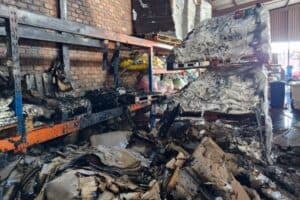A significant cache of explosives and military equipment was unearthed in Springs, raising serious safety concerns for the community.

A substantial and potentially life-threatening arms cache was discovered buried at a suburban home in Springs, Ekurhuleni, yesterday.
There were enough explosives buried in the house’s backyard to destroy several residential blocks and potentially kill or maim many people.
The SA Police Service (Saps) bomb disposal unit spent a large portion of the day combing the home’s yard for unexploded ordinance, after arresting the property owner, a 61-year-old man who purportedly served in pre-1994 administration law enforcement.
Life-threatening cache found in Springs
A total of 36 60mm mortar shells, as well as several rounds of ammunition, R5 assault rifle magazines and an illegal firearm were found by investigators, as well as an old South African flag, old police and military uniforms.
The uniforms included 36 pairs of military issue camouflage pants and other unlicensed and allegedly stolen military property.
The discovery of the mortar shells was made by a casual worker on the property, said Springs Saps spokesperson Themba Tshabalala.
ALSO READ: DIY explosives found at KZN mosque, police search for suspects
According to initial reports, the property owner allegedly first told the worker “not to dig at a certain spot in the garden, because he buried some explosives there” a few days before.
After the owner went to town, the labourer went back to the spot and, instead of compost, his fork turned up a 60mm mortar.
Authorities were immediately alerted and dispatched to the scene, according to a source close to the investigation.
Springs property owner a collector of military memorabilia
The property owner, purportedly a collector of military memorabilia, purchased the mortars from an unidentified source.
He allegedly removed the rear fins from the projectiles, along with the fuses, for their resale value and then instructed another casual worker to bury it in the garden, the source said.
The bellies of the mortars still contained explosives.
ALSO READ: Three bomb squad members bust for pocketing money at crime scene
The 60mm shells are bombs fired from a tube, which are used by militaries for close support of ground troops. It has a high angle of fire and is shot from a portable cannon. It’s got enough firepower to disable or destroy a small tank.
The former South African Defence Force (SADF) used these “patrol mortars” extensively during the war in Angola in the ’80s.
Jimmy Roodt, explosives and operations manager of Gauntlet Security Solutions, said each shell could contain up to 400g of explosive material. The mortars would collectively contain between 9kg-14kg of pure explosive substance.
Mortars contain pure explosive substance
“Add to that the additional damage-causing materials that cause shrapnel, like the casing or possibly items like ball bearings inside the device, and the danger escalates to well over 70kg collectively,” Roodt said.
Should all the mortars detonate at once, the instant kill zone could extend up to 50m, while anything or anyone within a 900m-range would face severe injury or damage from the blast or the fragmentation, he added.
A former military intelligence operative told The Citizen the kill zone for an individual mortar shell of the size found in the suspect’s garden would be around 8m, with a potential injury area of more than 100m.
ALSO READ: Two arrested at Beitbridge border post for smuggling illegal explosives
While the removal of the detonators would have made the ordnance mostly safe, factors like rusting shells, radiated heat and even earth tremors could have sparked an explosion under specific conditions, depending on the decay and volatility of the explosives inside, he added.
Neighbours, who were at home at the time of the police activity, were shell-shocked. They asked to remain anonymous.
One man said that it was impossible to imagine the disaster that could have occurred had something gone wrong with the explosives.
‘Imagine if a disaster happened’
Another said she never expected the suspect to have taken his interest in military memorabilia that far, nor bring danger so deep into the community.
Unexploded ordinance can remain alive and potentially dangerous for extended periods of time.
Last week, a Japanese airport had to be closed down when a buried World War II bomb, now nearly 80 years old, exploded under a runway.
ALSO READ: Police nab four for supplying explosives used to bomb ATMs and cash vans
The blast created a large crater in the taxiway and although there were no injuries, it delayed more than 80 flights.
Roodt said it is illegal to be in possession of any military ordinance.
Illegal to posses any military ordinance
The police can charge the man with the illegal possession of firearms, explosives and military equipment.
“Due to the significant number of mortars found on the property, the man could possibly face terrorism charges, too,” he said.






